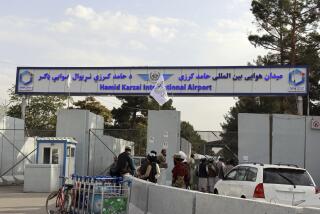NATO kills 5 Afghan soldiers in mistaken airstrike
- Share via
Reporting from Kabul, Afghanistan — Army Gen. David H. Petraeus on Wednesday marked an early and unwelcome milestone in his tenure as commander of Western forces here: apologizing for his troops having accidentally killed five Afghan soldiers.
“Friendly fire” incidents are relatively rare, but they stir animosity among many in the Afghan military, whose partnership with the NATO force is central to President Obama’s hopes that American troops can begin drawing down a year from now.
Afghan and North Atlantic Treaty Organization officials said the incident was under investigation, but such accidental deaths have been blamed on poor communication and coordination and often on nighttime confusion.
The five Afghan soldiers were killed by a NATO airstrike as they prepared to launch a predawn attack on insurgents in the Andar district of Ghazni province, in central Afghanistan. Western spotters apparently mistook the Afghan troops for armed militants.
Petraeus, who formally assumed command of NATO’s International Security Assistance Force on Sunday, conveyed personal regrets to the Afghan government, said Brig. Gen. Josef Blotz of Germany, an ISAF spokesman.
Afghan officials, though, made it clear that such occurrences carry a political cost.
“We strongly condemn this incident,” said Afghan Defense Ministry spokesman Gen. Mohammed Zahir Azimi. “Unfortunately, this is not the first time it happened.... We hope at least this would be the last.”
Azimi said the 4 a.m. airstrike occurred without warning. In addition to the five dead, two Afghan soldiers were wounded.
Western military officials also had losses of their own to report: the deaths of three American soldiers a day earlier in a single explosion in the south. Insurgents have been using massive roadside bombs that can penetrate many of the armored vehicles used by NATO forces. As a result, it is not unusual for Western troops to die in clusters of three or more.
Newly arriving American troops — part of a 30,000-strong buildup ordered by Obama late last year that will bring U.S. force numbers to 100,000 by summer’s end — are mainly being deployed in the south, the scene of a major Western military campaign that is unfolding, somewhat behind schedule, around the city of Kandahar.
The south is the most lethal battlefield for Americans and the other national contingents serving there, primarily Canadian and British troops.
Britain said Wednesday that it would soon turn over one of the most dangerous districts of Helmand province in the south to American forces. About a third of the more than 300 deaths of British soldiers in Afghanistan have occurred in the district, Sangin.
In London, Liam Fox, Britain’s new defense secretary, told Parliament that British forces in Helmand have long been “too thinly spread.” With the arrival of thousands more U.S. Marines, he said, British troops would redeploy elsewhere in the province.
In a videoconference with Pentagon reporters, Army Lt. Gen. David Rodriguez, the deputy commander in Afghanistan, described the move as an effort to consolidate and better organize forces in Helmand. He played down suggestions that the step was in response to losses incurred by the 800-man British force in Sangin.
Rodriguez said the British would stay in the district through the peak summer fighting season and until after elections scheduled for fall.
“The Brits have continued to make progress,” he said. “It is hard-earned, because it’s a tough place.”
The move will leave U.S. Marines in control of the northern Helmand River Valley, British forces toward the middle and U.S. forces in the south. The move will concentrate British troops “where we need them most,” Rodriguez said.
Times staff writers Henry Chu in London and David S. Cloud in Washington contributed to this report.
More to Read
Sign up for Essential California
The most important California stories and recommendations in your inbox every morning.
You may occasionally receive promotional content from the Los Angeles Times.













